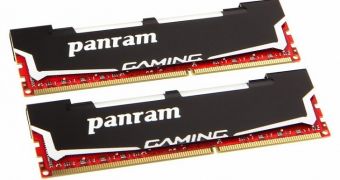When it comes to DDR3, there are several ways to classify the different modules and kits, but mostly, people tend to check for a heatspreader before looking any deeper. The presence of a heatspreader automatically means better than average performance after all.
That's why people glancing at the latest product from PANRAM will instantly figure out that it's not a random, pedestrian kit for average systems.
On the other hand, onlookers might have trouble figuring out what the thing is supposed to look like, assuming they even realize that the RAM is trying to imitate something else.
We may as well throw it out there: PANRAM intended for the new Light Sword DDR3 memory modules to look like a lightsaber.
Admittedly, the top part of the heatsink is rounded. The rest of the item doesn't exactly scream “laser-projecting chrome cylinder of doom” though.
Nevertheless, PANRAM is advertising the Light Sword DDR3 modules as lightsaber replicas, a homage to Star Wars.
Obviously, it's an homage, of sorts, to Lucas Arts for their decision to take up the Star Wars series once again.
So what can the memory actually do? For one thing, run at up to 2400 MHz, and even support overclocking to 2666 MHz.
The capacity of the kit is 8 GB, thanks to both modules having 4 GB. The latency is of CL 11-13-13-35 if you wanted to know.
Not exactly the best, but it's understandable that they would be so high. They always get higher the faster the frequency becomes.
The heatsinks are colored black, like the majority of the heatspreaders themselves (which are made of the normally metallic grey aluminum). Furthermore, the memory comes with red LED lighting.
Moving on, the modules that make up the new kit are Intel XMP 1.3 certified. In other words, they meet the highest demands for gaming-grade / enthusiast memory.
Finally, PANRAM assures us that the Light Sword dual-channel memory kit can be used in quad-channel mode if you have a four-DIMM motherboard and buy a second set of similar RAM.
All in all, the dual-channel kit costs €70, which can mean $70 (knowing how exchange rates rarely seem to matter) and something in the vicinity of $97 (if retailers really do take exchange rates into account).
Since the RAM was released in Europe, we assume that the latter situation is true, especially if shipping and custom taxes come into play. Fortunately for PANRAM, enthusiast PC builders usually have the money for hardcore purchases.

 14 DAY TRIAL //
14 DAY TRIAL //